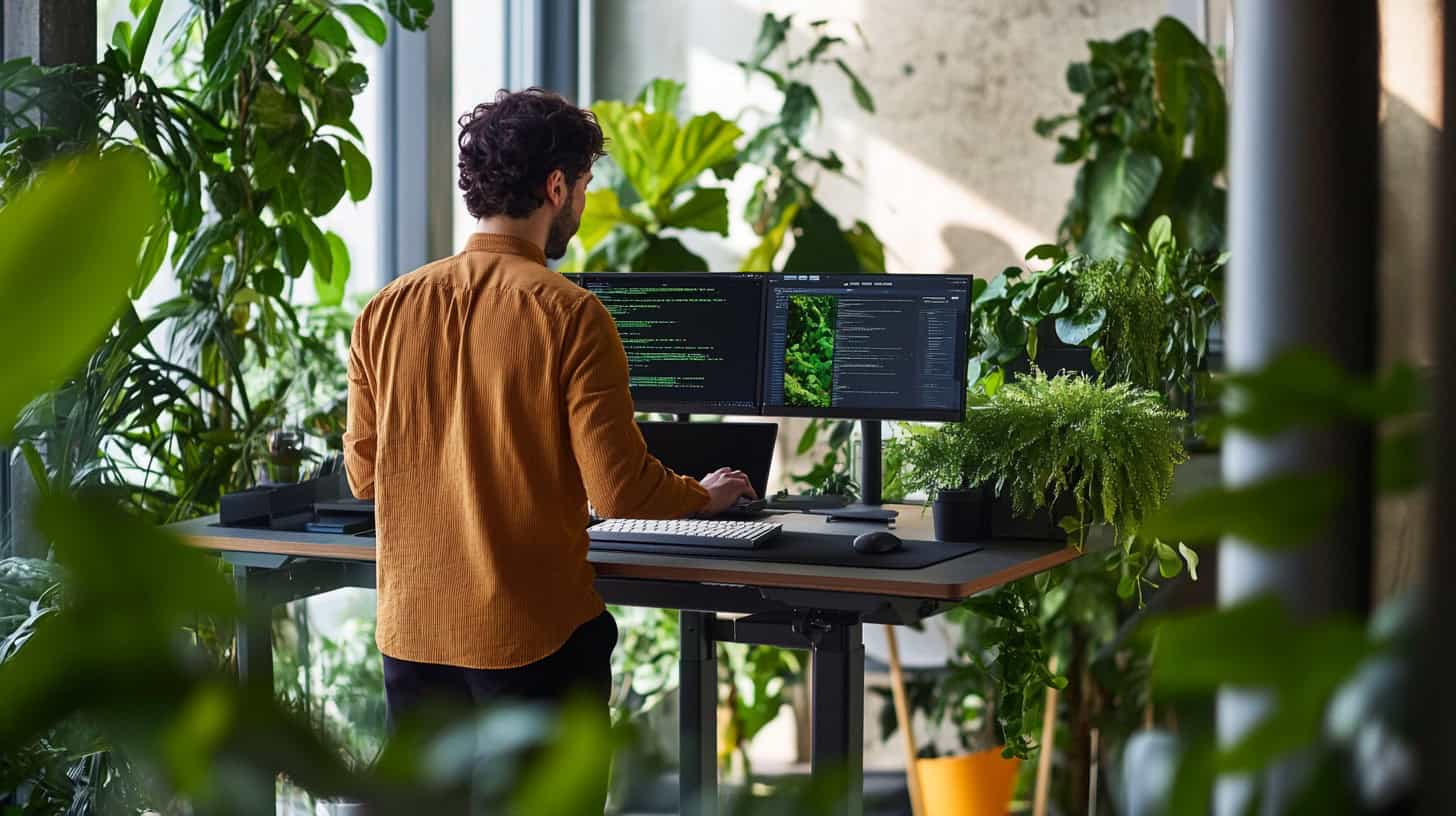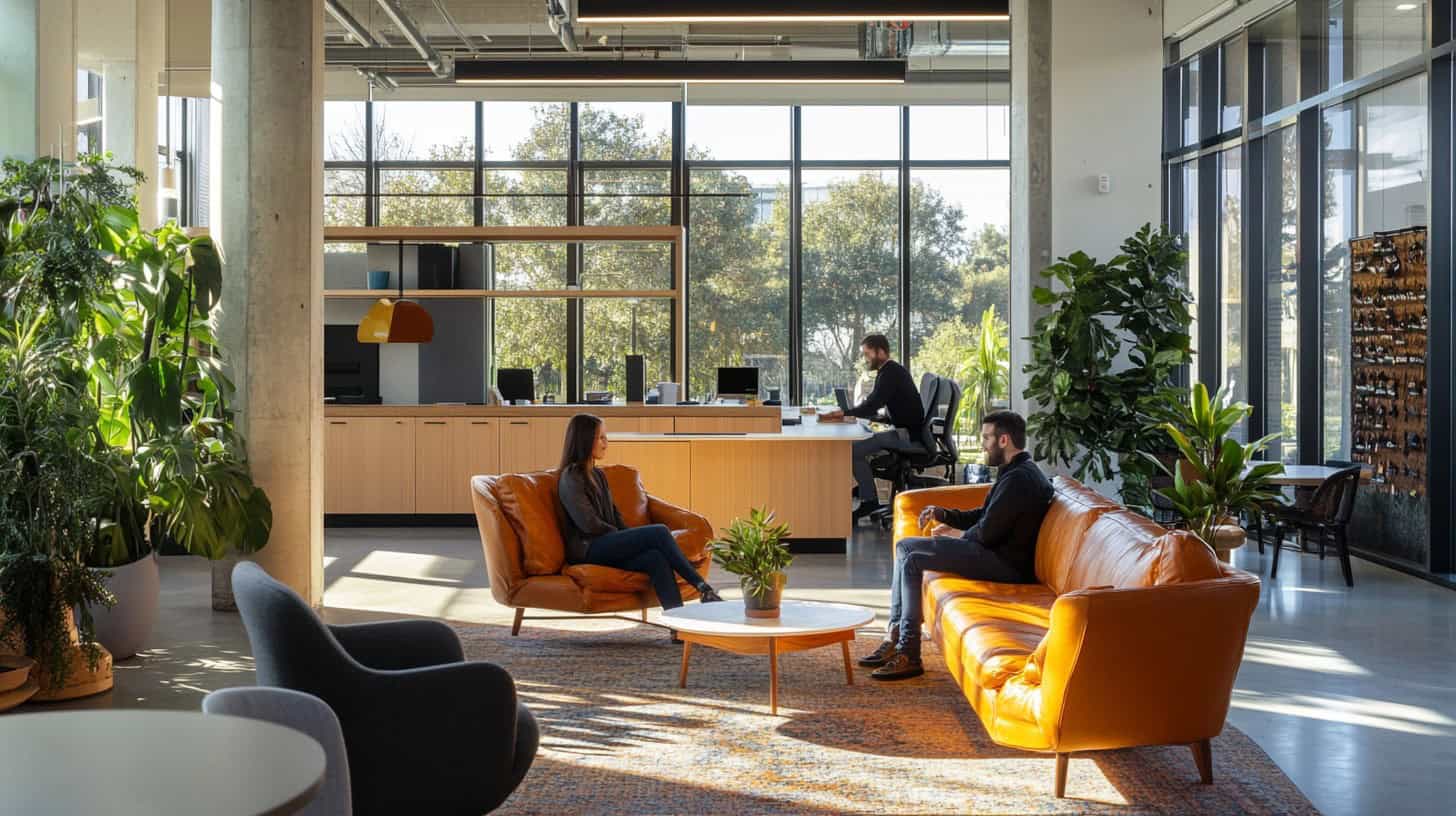Coding for hours can drain your energy and creativity. Studies show that taking regular breaks improves focus and productivity. 3 This article offers 8 clever hacks to refresh your mind while coding. 2
Learn how to boost your efficiency and avoid burnout. 1
Key Takeaways
Taking regular 5-10 minute breaks every hour can boost coding productivity by up to 30%.
The Pomodoro Technique, using 25-minute work sprints followed by 5-minute breaks, helps maintain peak performance for programmers.
Deep breathing exercises, quick stretches, and short walks during breaks can reduce mental fatigue and enhance problem-solving abilities.
Reading unrelated materials, solving puzzles, or playing brief games during breaks can stimulate different brain areas and refresh your mind.
Using apps like Workrave or Toggle Track can help manage break times effectively and remind coders to take regular pauses from screen time.
Table of Contents
Why Taking Breaks Boosts Coding Efficiency

Breaks are a coder’s secret weapon. They recharge your brain, sharpen your focus, and spark fresh ideas – making you a more efficient programmer.
Enhancing Focus and Productivity
Coding demands intense concentration. Regular breaks boost focus and productivity. Studies show 5-10 minute pauses every hour can increase output by 30%. 2 The Pomodoro Technique, using 25-minute work sprints followed by 5-minute breaks, helps maintain peak performance. 1 Google and Apple promote break-taking to prevent burnout and foster creativity.
Take breaks to make breakthroughs. – Jason Baker
Short pauses refresh the mind, allowing for better problem-solving. They reduce eye strain from screen time and prevent mental fatigue. Stretching or walking during breaks improves blood flow, enhancing cognitive function.
Programmers who take regular breaks report fewer bugs and faster debugging sessions.
Reducing Mental Fatigue
Mental fatigue often follows intense focus. Programmers face this challenge daily. Taking regular breaks reduces mental exhaustion, improving overall productivity. Studies show that sitting for long periods increases health risks.
The American Heart Association links each hour of sedentary behavior to higher cardiovascular disease risk.
Implementing the Pomodoro Technique combats mental fatigue effectively. This method involves 25-minute work sprints followed by 5-minute breaks. It aligns with our brain’s natural rhythm, preventing burnout.
Geeks benefit from this structured approach, maintaining peak performance throughout coding sessions. Short walks or stretches during breaks boost blood flow, energizing both body and mind.
Mindfulness exercises or quick meditation sessions reset mental clarity, enhancing problem-solving abilities for complex coding tasks.
Encouraging Creative Thinking
Creative thinking thrives on breaks. Stepping away from code refreshes the mind, sparking new ideas and solutions. A University of Illinois study found brief diversions boost task focus over time.
This applies perfectly to coding – a quick break can lead to that “eureka moment” where complex problems suddenly become clear. 5
Programmers often experience breakthroughs during downtime. Google and Apple recognize this, actively promoting break-taking to prevent burnout and foster innovation. Many developers report that disengaging from incorrect solutions allows them to approach problems with fresh eyes.
This mental reset can be the key to unlocking stubborn bugs or designing elegant algorithms. 2
Reimagining

Reimagining breaks can transform your coding experience. It’s about finding new ways to recharge that fit your lifestyle and boost your productivity.
Exploring Vaping as a Less Harmful Alternative
Vaping presents a potentially less harmful alternative to traditional smoking. E-cigarettes heat liquid nicotine, producing vapor instead of smoke. This process eliminates many toxic chemicals found in cigarette smoke.
Geek Bar disposable vapes offer a convenient option for those looking to transition away from cigarettes. Research indicates vaping may be up to 95% less harmful than smoking tobacco. 7
Vaping isn’t harmless, but it’s a step towards harm reduction for smokers, says Dr. Michael Siegel, tobacco control expert.
Users report reduced coughing and improved lung function after switching to vaping. Yet, long-term effects remain unclear. Further research is needed to fully understand vaping’s health impacts.
Nicotine addiction persists with e-cigarettes, so users should approach vaping carefully as a potential smoking cessation aid. 6
Using Nicotine Replacement Therapy (NRT) Products
NRT products offer a safer alternative for coders looking to quit smoking. Patches, gum, and lozenges deliver controlled nicotine doses without harmful tobacco chemicals. 8 These FDA-approved aids reduce cravings and withdrawal symptoms, allowing developers to focus on their work.
Studies show NRT can double quitting success rates compared to going cold turkey. 9
Programmers can integrate NRT into their break routines for optimal results. Applying a patch before starting work provides steady nicotine release throughout coding sessions. Chewing nicotine gum during short breaks helps manage sudden cravings.
Lozenges offer discreet relief during team meetings or pair programming. Combining NRT with other break strategies like stretching or meditation enhances its effectiveness for busy devs.
Practicing Deep Breathing Exercises
Transitioning from NRT products, deep breathing exercises offer a natural, cost-free alternative for stress relief. These techniques can reset your mental state during coding sessions.
Take 5 deep breaths, inhaling for 4 seconds and exhaling for 6 seconds. 11 This simple practice activates the parasympathetic nervous system, reducing cortisol levels and promoting clarity.
Deep breathing exercises provide mental breaks and fresh perspectives on coding problems. Programmers can integrate this technique into their workflow by using apps like Calm or Headspace.
Set reminders every 2 hours to pause and breathe deeply for 60 seconds. This habit enhances focus, boosts creativity, and reduces eye strain – crucial benefits for software developers facing complex algorithms or debugging tasks. 10
Break Strategies Tailored for Programmers

Programmers need smart break strategies to stay sharp. The Pomodoro Technique, scheduled mini-breaks, and deep work sessions can boost your coding efficiency. Want to know more? Keep reading!
Implementing the Pomodoro Technique
The Pomodoro Technique boosts coding efficiency through structured work-rest cycles. This method, created by Francesco Cirillo, uses 25-minute focus periods followed by short breaks. 12
- Set a timer for 25 minutes and code with full concentration
- After the timer rings, take a 5-minute break to stretch or relax
- Repeat this cycle four times, then take a longer 15-30 minute break
- Use tools like Toggle Track or Pomodoro plugins for IntelliJ and Visual Studio Code
- During breaks, step away from your screen to reduce eye strain
- Engage in quick physical activities like desk stretches or a brief walk
- Tackle complex problems during your focused 25-minute sessions
- Use breaks to reflect on your progress and plan next steps 13
- Adjust the technique to fit your personal rhythm and project demands
Let’s explore how physical activities can enhance your break time effectiveness.
Planning Scheduled Mini-Breaks
Scheduled mini-breaks boost coding efficiency and mental well-being. Implementing structured pauses throughout your workday enhances focus and reduces mental fatigue. 14
- Set 5-minute breaks every 30 minutes or 10-minute breaks hourly
- Use Workrave to automate break reminders – “user2567” recommends 10-minute breaks every 45 minutes
- Physically move away from your screen during breaks, as advised by Dean Harding
- Incorporate quick stretches or light exercises to combat sedentary effects
- Practice deep breathing exercises to reset your mind and reduce stress
- Solve small puzzles or play brief games to stimulate different brain areas
- Read unrelated materials to give your coding mind a rest
- Take short walks to boost blood flow and creativity
- Use fitness trackers to encourage movement during breaks
- Access guided relaxation exercises online for mental refreshment
Next, we’ll explore methods for mental refreshment during your coding breaks. 15
Integrating Deep Work Sessions with Pauses
Building on scheduled mini-breaks, let’s explore deep work sessions with strategic pauses. This approach combines intense focus with rejuvenating breaks to maximize productivity and mental clarity.
- Cal Newport’s “Deep Work” method advocates for 90-minute focused sessions followed by 20-minute breaks
- Use a timer to track work periods and enforce strict break times
- During breaks, step away from screens and engage in physical activities like stretching or short walks 14
- Alternate between high-intensity tasks and less demanding work to maintain mental energy
- Implement a “no interruptions” policy during deep work sessions to maintain flow state
- Use break times for quick meditation or mindfulness exercises to reset focus 16
- Track productivity levels to optimize work-to-break ratios for your personal rhythm
- Limit caffeine intake during work sessions to avoid energy crashes
- Use break times to hydrate and snack on brain-boosting foods
- Experiment with different deep work session lengths to find your optimal focus time
Physical Activities for Effective Breaks

Physical movement boosts your coding game. Quick stretches, walks, or light workouts can recharge your brain and body.
Performing Quick Stretching Routines
Quick stretching routines boost productivity and prevent injuries for programmers. 17 These simple exercises combat fatigue, stress, and burnout during coding sessions.
- Stand up and reach for the sky, holding for 10 seconds
- Roll shoulders backward 5 times, then forward 5 times
- Stretch neck by tilting head to each side for 5 seconds
- Clasp hands behind back and pull shoulders down for 10 seconds
- Rotate wrists 10 times clockwise, then counterclockwise
- Stretch hamstrings by touching toes for 15 seconds
- Do 10 desk push-ups to engage arm and chest muscles
- Perform 5 lunges on each leg to stretch hip flexors
- Twist torso side to side 10 times while seated
- Shake out hands and arms for 15 seconds to improve circulation 18
Taking Short Walks
Short walks during coding breaks offer a powerful refresh for programmers. These brief strolls provide physical and mental benefits, boosting productivity and creativity.
- Step away from your desk for 5-10 minutes every hour
- Walk around your office, building, or outside if possible
- Use this time to stretch your legs and get your blood flowing
- Focus on deep breathing to oxygenate your brain
- Let your mind wander to encourage creative problem-solving
- Jason Viers notes walks help gain new coding insights. 15
- Consider walking meetings for collaborative problem-solving
- Track your steps with a fitness app to motivate movement
- Aim for at least 250 steps per break to combat sedentary effects. 19
- Use walks to combat eye strain by focusing on distant objects
- Listen to podcasts or audiobooks for continued learning
- Practice mindfulness by observing your surroundings
- Use walks as a chance to hydrate and refuel your body
- Return to your desk feeling energized and focused
Engaging in Light Exercises
Light exercises during coding breaks can significantly boost your energy and focus. 17 These simple activities help combat the negative effects of prolonged sitting and mental strain. 20
- Stand up and do 10-15 jumping jacks to get your blood flowing
- Perform 5-10 desk push-ups to engage your upper body muscles
- Try 20 seconds of high knees marching in place for a quick cardio burst
- Do 10 slow neck rolls to relieve tension in your neck and shoulders
- Complete 15 leg lifts while seated to work your core and lower body
- Stretch your arms overhead and lean side to side 5 times each way
- Walk up and down a flight of stairs for 2-3 minutes
- Hold a plank position for 30 seconds to strengthen your core
- Do 10 bodyweight squats to engage large muscle groups
- Perform 30 seconds of arm circles forward and backward
Methods for Mental Refreshment

Mental breaks are crucial for coders. They recharge your brain and spark fresh ideas.
Practicing Meditation or Mindfulness
Meditation and mindfulness provide effective techniques for mental refreshment during coding breaks. These practices can significantly improve productivity and well-being, as experienced by developer Bob Murphy. 22
- Start with short sessions: Begin with 2-3 minute mindfulness exercises, gradually increasing to 10-15 minutes.
- Use guided meditations: Apps like Headspace or Calm offer structured sessions suitable for beginners.
- Focus on breath: Count inhales and exhales to center your attention and calm racing thoughts.
- Body scan technique: Systematically relax each part of your body from toes to head. 21
- Mindful coding: Apply awareness to your programming process, observing thoughts without judgment.
- Set reminders: Use apps like Workrave to prompt regular mindfulness breaks throughout your day.
- Practice consistently: Aim for daily sessions to build the habit and experience long-term benefits.
- Join a community: Connect with other developers interested in mindfulness through online forums or local groups.
Physical activities complement mental exercises in maintaining overall well-being during coding sessions.
Reading Unrelated Materials
Shifting gears from mindfulness, let’s explore another mental refreshment technique. Reading unrelated materials offers a cognitive break, allowing programmers to reset their focus and return to coding with renewed energy. 23
- Read fiction: Escape into imaginary worlds for 15-20 minutes. This mental vacation stimulates creativity and problem-solving skills.
- Explore tech blogs: Read about emerging technologies or programming languages outside your current project. This broadens your knowledge base and sparks innovative thinking.
- Scan news articles: Stay informed on current events. This brief detachment from code helps maintain work-life balance and perspective.
- Read scientific journals: Engage with cutting-edge research. This intellectual stimulation can lead to novel approaches in your coding work.
- Browse humor websites: Laugh for 5-10 minutes. Laughter reduces stress hormones and boosts mood, enhancing productivity upon return to work. 14
- Read poetry or short stories: Engage with concise, impactful writing. This exercise in brevity can improve your code commenting skills.
- Study a new language: Spend 10 minutes on language learning apps. This cognitive exercise strengthens neural pathways, benefiting overall brain function.
- Review industry whitepapers: Gain insights into broader tech trends. This contextual understanding can inform your coding decisions and career growth.
Solving Puzzles or Playing Games
Engaging in puzzles or games during breaks sharpens cognitive skills. These activities offer a mental refresh while keeping the brain active.
- Sudoku: Improves logical thinking and pattern recognition
- Crosswords: Enhances vocabulary and verbal reasoning
- Chess: Boosts strategic planning and foresight
- Rubik’s Cube: Develops spatial awareness and problem-solving
- Jigsaw puzzles: Increases visual perception and patience
- Casual games: Provide quick, fun mental stimulation
- Logic puzzles: Strengthen analytical thinking and deduction
- Word searches: Improve focus and attention to detail
- Memory games: Enhance short-term recall and concentration
- Math games: Sharpen numerical skills and mental arithmetic
These brain teasers offer a productive break from coding, keeping the mind agile. 24 Next, we’ll explore how to optimize your workspace for effective breaks. 25
Optimizing Your Workspace for Breaks

Your workspace can make or break your break time. Set up a cozy corner, adjust your lighting, and play some soothing tunes… Want to know more about creating the perfect break space? Keep reading!
Creating Relaxing Spaces
Transform a corner of your workspace into a mini-oasis. Add plants for improved air quality and stress reduction. Soft lighting, like a desk lamp with warm bulbs, creates a calming atmosphere.
Comfortable seating – a plush chair or cushions – invites relaxation during breaks. Personal touches, such as photos or artwork, make the space uniquely yours.
Incorporate elements that engage multiple senses. A small fountain provides soothing white noise. Essential oil diffusers offer calming scents like lavender or eucalyptus. Tactile objects, such as stress balls or fidget toys, give hands something to do during mental breaks.
These sensory inputs help reset your mind, boosting focus when you return to coding tasks. 26 15
Ensuring Adequate Lighting and Ergonomics
Proper lighting and ergonomics boost coding productivity and health. Optimal illumination reduces eyestrain and headaches, common issues for programmers. 27 Ergonomic setups cut the risk of muscular-skeletal disorders by 50%.
Adjust your monitor height to eye level, keep your keyboard at elbow height, and use a chair with lumbar support. Natural light or full-spectrum bulbs mimic daylight, enhancing mood and focus.
Desk lamps with adjustable brightness offer personalized lighting control.
Indoor air quality impacts cognitive performance. 27 Open windows or use air purifiers to maintain fresh air flow. Plants like snake plants or peace lilies can improve air quality naturally.
Consider standing desks or treadmill desks to alternate between sitting and standing throughout the day. These simple tweaks create a more comfortable and efficient coding environment.
Next, let’s explore how technological tools can help manage your break times effectively. 15
Utilizing Ambient Sounds or Music
Proper lighting and ergonomics create an effective coding environment. Background sounds or music can improve your workspace. Research indicates that ambient audio increases productivity and problem-solving abilities. 28 Services such as Brain.fm provide AI-generated soundscapes designed for concentration. Natural sounds, including rain or ocean waves, can cover disruptive noises and encourage relaxation.
Instrumental music, particularly lo-fi or classical styles, offers a rhythm without vocal distractions. 12 Try various audio types to discover what enhances your coding productivity.
Technological Tools for Managing Break Times

Tech can be your break buddy. Apps and gadgets help you pause and recharge without missing a beat.
Using Apps for Break Reminders and Time Management
Apps for break reminders and time management increase coding efficiency. These digital tools help programmers maintain focus and avoid burnout.
- Workrave: Popular among developers, it sends alerts for micro-breaks and longer rest periods. Its customizable settings accommodate various coding rhythms.
- Dejal Time Out: Dims the screen at set intervals, encouraging eyes off the monitor. It syncs across devices for consistent break schedules. 29
- Toggle Track: Offers Pomodoro plugins for IDEs like IntelliJ and Visual Studio Code. It tracks work sessions and automates break timing.
- Forest: Turns the break process into a game by growing virtual trees during focused work periods. It discourages phone use during coding sessions.
- StandApp: Reminds coders to stand up and move regularly. It integrates with fitness trackers for personalized activity goals.
- RescueTime: Analyzes time spent on different coding tasks. It recommends optimal break times based on productivity patterns.
- Focus@Will: Provides background music designed to enhance concentration. It includes built-in work/break timers.
- Stretchly: Open-source app that prompts stretching exercises suited for desk workers. It educates on ergonomics between coding sprints. 30
Employing Fitness Trackers for Movement Encouragement
From app-based reminders, we move to wearable tech for movement tracking. Fitness trackers offer a hands-free approach to monitoring physical activity during coding breaks. 31
- Wrist-worn devices track steps, heart rate, and calories burned
- Set daily movement goals (e.g., 250 steps per hour) to combat sedentary coding
- Vibration alerts remind you to stand up and move every hour
- Sync data with smartphone apps for progress visualization
- Gamification features (badges, challenges) boost motivation
- Some trackers offer guided breathing exercises for stress relief
- Water-resistant models allow for tracking during quick shower breaks
- Sleep tracking functions help coders monitor rest quality 32
- GPS-enabled devices map short walks around the office or neighborhood
- Social features let you compete with fellow devs for most active breaks
Accessing Guided Relaxation Exercises Online
Online platforms offer a wealth of guided relaxation exercises for programmers seeking mental refreshment. These digital resources provide easy access to stress-relief techniques optimized for busy developers. 33
- Explore meditation apps like Headspace or Calm for short, focused sessions
- Use YouTube channels dedicated to programmer relaxation, featuring coding-themed guided visualizations
- Access free mindfulness exercises through websites like Mindful.org or FreeMindfullness.org
- Try AI-powered relaxation tools that adjust to your stress levels and work patterns
- Join online communities for group meditation sessions with fellow developers
- Download podcasts with guided progressive muscle relaxation specifically for tech professionals
- Use browser extensions that offer micro-breaks with breathing exercises 17
- Experiment with VR relaxation experiences designed to transport you from your desk
Fostering a Break-friendly Team Culture

Create a team culture that values breaks. Encourage group activities during downtime to boost morale and reduce imposter syndrome.
Promoting Team Breaks
Team breaks foster a healthier work environment and boost overall productivity. Google and Apple, tech industry leaders, actively promote break-taking to prevent burnout among their developers. 34
- Schedule synchronized team breaks: Set specific times for the entire team to pause coding simultaneously. This approach ensures everyone gets a chance to recharge without feeling left behind.
- Create break-friendly spaces: Designate areas in the office for relaxation and social interaction. These spaces encourage developers to step away from their screens and engage in casual conversations.
- Implement “walking meetings“: Replace some sit-down meetings with short walks. This strategy combines physical activity with problem-solving, enhancing creativity and reducing mental fatigue.
- Organize team-building activities during breaks: Plan quick, fun exercises that promote bonding and reduce imposter syndrome. These activities can range from brief coding challenges to non-work-related games.
- Encourage break accountability partners: Pair team members to remind each other to take breaks. This system helps combat the tendency to overwork and promotes a culture of mutual care.
- Share break ideas in team chats: Use online community platforms to exchange suggestions for effective break activities. This practice keeps breaks fresh and engaging for all team members.
- Track and celebrate break goals: Use fitness trackers or apps to monitor team break habits. Recognize and reward teams that consistently take healthy breaks, reinforcing positive behavior. 35
- Rotate break activity leaders: Assign different team members to lead short group activities during breaks. This approach taps into diverse interests and skills within the team, making breaks more appealing to everyone.
Sharing Break Activities
Sharing break activities fosters team bonding and enhances overall productivity. 35 Here are effective ways to share break activities with your fellow developers:
- Create a ‘Break Board’: Set up a physical or digital board where team members post fun break ideas or challenges. This encourages creativity and variety in break activities.
- Organize ‘Code-Free’ Zones: Designate specific areas where team members can engage in non-work activities during breaks. These zones could include game corners or relaxation spots.
- Implement ‘Tech-Free’ Breaks: Encourage breaks without screens to reduce eye strain and mental fatigue. Suggest activities like puzzles, card games, or short walks.
- Host Mini-Tournaments: Organize quick competitions in activities like foosball, ping pong, or even coding challenges. This adds a fun, competitive element to breaks. 36
- Share Learning Moments: Use break times for brief knowledge-sharing sessions. Team members can present interesting tech facts or demonstrate cool coding tricks.
- Collaborative Art Projects: Start ongoing art projects that team members can contribute to during breaks. This could be a mural, a LEGO build, or a collaborative coding project.
- Group Stretching Sessions: Lead short group stretching or exercise routines. This promotes physical well-being and team synchronization.
- Virtual Break Rooms: For remote teams, create virtual spaces where members can hang out and chat during breaks, mimicking water cooler conversations.
Establishing Collective Break Goals
Building on shared break activities, teams can set collective break goals. This approach fosters a culture of wellness and productivity. 36 Here’s how to establish effective collective break goals:
- Set measurable targets: Define specific, achievable goals like “Take 5-minute breaks every hour” or “Complete 3 group stretching sessions per week.”
- Use team productivity tools: Implement apps like Trello or Asana to track break goals and progress as a unit.
- Create a break leaderboard: Gamify the process with a friendly competition, rewarding teams or individuals who consistently meet break targets.
- Schedule group breaks: Align break times for pair programming or collaborative tasks to enhance team cohesion.
- Rotate break activities: Assign team members to lead different break activities each week, promoting variety and engagement.
- Track collective benefits: Monitor team productivity, code quality, and bug reduction rates to demonstrate the positive impact of regular breaks. 37
- Encourage peer accountability: Form break buddies or small groups to support each other in maintaining healthy break habits.
- Adapt goals based on feedback: Regularly assess and adjust collective break goals to match team needs and project demands.
- Celebrate milestones: Acknowledge team success in meeting break goals with small rewards or recognition during stand-ups.
- Share success stories: Highlight how breaks improved problem-solving or led to creative solutions in team retrospectives.
People Also Ask
Why are breaks important for coders?
Breaks boost memory retention and mental health. They help troubleshoot issues. Joel Spolsky says our conscious mind needs rest. Breaks refresh willpower and combat sleep deprivation.
How can exercise help during coding breaks?
Exercise boosts neurotransmitters. It fights anxiety and mental fatigue. Short workouts improve focus. They’re better than caffeinated drinks for energy.
Is meditation useful for coders?
Yes. Meditating calms the mind. It reduces stress from coding challenges. Even brief sessions help. They improve discipline and mental clarity.
Should I avoid social media during breaks?
Limit social media use. It can increase anxiety. Instead, try offline activities. They’re more refreshing for your brain.
How does sleep affect coding performance?
Lack of sleep hurts coding skills. It reduces problem-solving ability. Good sleep improves memory and focus. It’s crucial for maintaining motivations and learning capacity.
References
^ https://medium.com/@lightsoffire/how-taking-breaks-while-developing-software-can-make-you-more-effective-862e9556996b
^ https://softwareengineering.stackexchange.com/questions/16595/is-taking-frequent-breaks-really-that-beneficial-when-programming
^ https://www.ncbi.nlm.nih.gov/pmc/articles/PMC6585675/
^ https://www.wbscodingschool.com/blog/why-does-coding-make-me-so-tired/
^ https://hbr.org/2017/05/to-be-more-creative-schedule-your-breaks (2017-05-10)
^ https://store.samhsa.gov/sites/default/files/pep20-06-01-003.pdf
^ https://www.linkedin.com/posts/samuelsextonaus_there-is-no-good-evidence-that-vaping-is-activity-7103703563075276800-OhCc
^ https://smokefree.gov/tools-tips/how-to-quit/using-nicotine-replacement-therapy
^ https://www.ncbi.nlm.nih.gov/pmc/articles/PMC5003586/
^ https://www.ncbi.nlm.nih.gov/pmc/articles/PMC7064378/
^ https://matt-croak.medium.com/breathing-exercises-for-developers-6ea7848f746d
^ https://medium.com/@productplatform/volume-iii-coding-breaks-eba780dacb8c
^ https://todoist.com/productivity-methods/pomodoro-technique
^ https://dev.to/karan/how-to-take-breaks-while-coding-2ccp (2018-08-17)
^ https://thebulletin.medium.com/taking-breaks-as-a-developer-and-how-to-do-it-right-e0040b51832
^ https://todoist.com/inspiration/deep-work
^ https://www.linkedin.com/advice/3/what-some-effective-ways-take-breaks-while-programming-van5e
^ https://www.mitrecsports.com/wellness/8-stretches-study-break/ (2016-12-15)
^ https://hbr.org/2023/05/how-to-take-better-breaks-at-work-according-to-research (2023-05-31)
^ https://www.ncbi.nlm.nih.gov/pmc/articles/PMC8614732/
^ https://www.ncbi.nlm.nih.gov/pmc/articles/PMC7287297/
^ https://simpleprogrammer.com/a-programmers-guide-to-meditation/
^ https://drpicox.medium.com/the-emotional-and-technical-guide-to-rescue-stalled-software-e8aad48d95f4
^ https://dev.to/selawsky/8-coding-games-to-improve-and-level-up-your-programming-skills-3fc0 (2019-07-23)
^ https://www.linkedin.com/pulse/what-solving-puzzles-can-teach-you-work-life-a-j-jacobs
^ https://www.hubermanlab.com/episode/optimizing-workspace-for-productivity-focus-and-creativity (2022-01-30)
^ https://www.developernation.net/blog/how-to-optimize-workspace-to-improve-developers-productivity/ (2023-12-12)
^ https://javascript.plainenglish.io/taking-breaks-when-you-code-does-not-slow-you-down-97861fb95fc0 (2021-12-21)
^ https://apps.apple.com/us/app/time-out-break-reminders/id402592703?mt=12 (2024-03-13)
^ https://www.umsystem.edu/totalrewards/wellness/activity_and_break_apps
^ https://www.nytimes.com/2024/02/24/well/move/fitness-watch-tracker-wearable-data.html (2024-02-27)
^ https://www.lifespan.org/lifespan-living/how-fitness-trackers-can-help-you-manage-your-health (2023-12-12)
^ https://www.ncbi.nlm.nih.gov/pmc/articles/PMC9444703/
^ https://www.ezcater.com/lunchrush/office/breaks-works-creating-pro-break-culture-workplace/ (2018-02-20)
^ https://www.kumospace.com/blog/taking-breaks
^ https://www.robcampbellleadership.com/blog/05/22/2023/its-the-15-minute-break-which-counts-the-most (2023-05-22)


